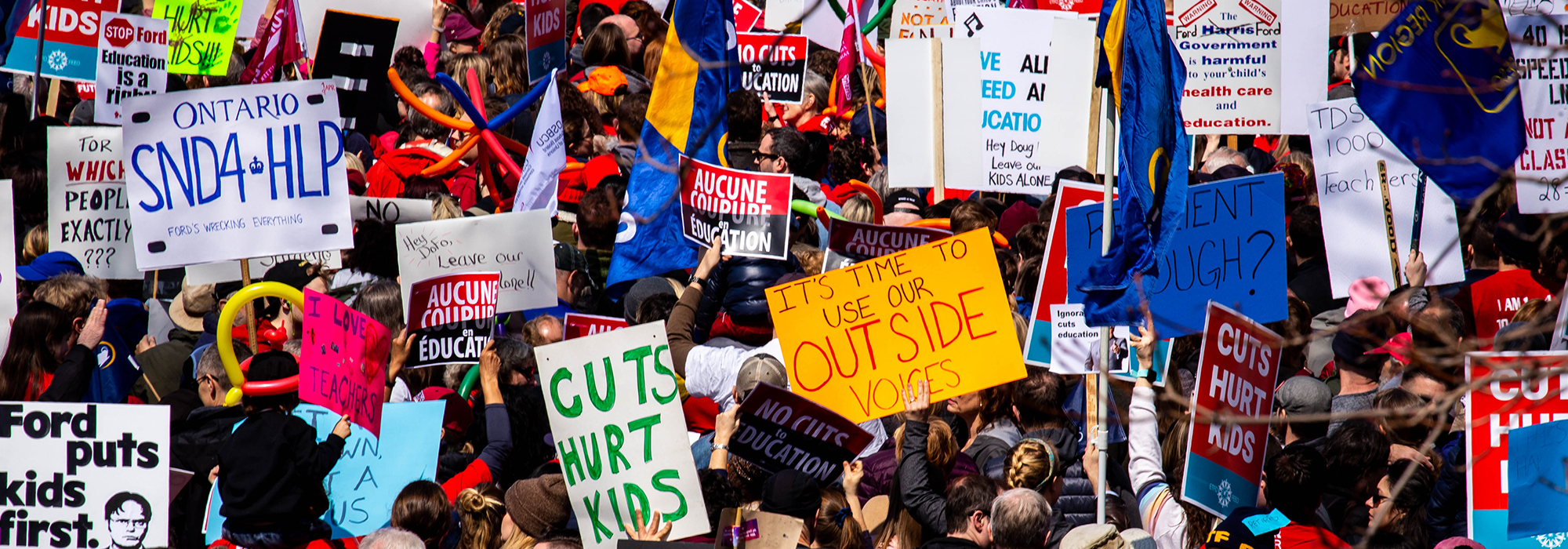
One eminent conservative scholar of public budgeting characterized annual budgets as a record of “victories, defeats, bargains and compromises.” Ontario’s 2019 Budget, the first of the new Conservative government of Doug Ford, does indeed tell us something of winners and losers with its additional fiscal supports for business and erosion of social expenditures for everyone else.
There is a line of continuity extending back from the Ford government to the Common Sense Revolution of the Harris and Eves governments of 1995-2003. Their market-expanding and labour-disciplining agenda established Ontario as a low-tax, low-cost regional production zone. Despite the shift to a more “inclusionary” political discourse, the Liberal governments of McGuinty and Wynne from 2003-18 never departed from this fiscal legacy and, for the most part, consolidated a variation of the same strategy.
Ontario budgetary practice has been to keep nominal growth in spending below the combined rate of growth in inflation and output, resulting in a steady reduction in the size of the public sector as a proportion of the provincial economy. Ontario now sits dead last among the provinces in per-capita government expenditures and more than $2,000 below the average for the rest of Canada. Program spending over the last decade has also been growing at half the rate it has been in the rest of Canada. The Ford budget, released in early April, aggressively amplifies this austerity logic (and makes absurd claims about an “austerity-lite” budget).
First, the 2019 budget further undermines the fiscal capacity to fund program spending adequately. Ontario now trails other provinces with lower personal and corporate tax rates and the lowest per-capita revenues. Still, revenues are cut in the order of $3.3 billion from scrapping carbon pricing, reducing the average marginal effective tax rate on business to 12.6 percent from 16 (well below the US average of 18.2 percent) through accelerated capital cost allowances, and cutting the small business deduction surtax to 3.5 percent from 11.5.
While Budget 2019 forecasts aggregate public expenditure to grow, when inflation and population growth are taken into account, in practice this entails a radical cut to per-capita program spending. The Ontario Public Service already has been reduced by 3.5 percent through a voluntary exit program alone, with further cuts planned across the public sector (with teachers and support staff already receiving layoff notices). As cuts to revenues and spending take hold, Ontario’s net-debt-to-provincial-GDP ratio will steadily decline to 38.6 percent from a current 40.2 percent over the term of the government (and after accounting for changes the Tories used to boost up net debt).
Second, the Conservatives have reordered an array of ministries and agencies to boost the development sector in general and resource extraction investment (oil, forestry, minerals, for example) in particular. This includes a major deregulatory agenda to be pursued through a task force with a mandate to reduce the “regulatory burden” by 25 percent, but also the creation of the Office of Economic Growth and Innovation, which will provide the capacity to coordinate and lead the deregulation agenda from within the provincial government.
A catalogue of cuts has followed, including the halving of Indigenous Affairs. This will slow a range of land claim and treaty settlement issues and also undermine processes of consultation and collaboration over resource development. The government is seeking to restrict regulatory processes and other obstacles to resource development in the Ring of Fire chromite development project in Northern Ontario, as well as a number of areas where conflicts over logging and mining exist. Further, the budget for Environment and Parks is to be cut by about 35 percent, which will gut already weakened enforcement capacities and further open up parks for commercialization and development.
Third, the Ford Budget explicitly targets reducing the costs of social provisioning and labour costs for business. Spending for the education sector is to grow on average only 1 percent per year for the next three years, meaning annual cuts in real terms. Health-care spending is to grow by a modest 1.6 percent per year over three years, but this is far below trend rates of growth in the sector, which in some cases have risen 4.5 percent. The single health-care agency being set up and the amalgamation of health districts are to facilitate a dramatic restructuring of health-care delivery with a view to further costs cut along the road to privatization.
Few ministries and programs have been left unscathed, including a $1-billion cut to social assistance. Budget 2019 puts $5 billion back into the pockets of the business community.
The third-largest proportional cut, nearly 25 percent, hits Municipal Affairs and Housing. The budget signals a market-driven strategy where regulations are to be “streamlined” (a euphemism for eroded) and development costs reduced to increase housing supply. But while the words “alcohol” and “beer” appear 46 times in the budget, the crisis of housing affordability does not merit a mention. The stock of Toronto Community Housing units in need of major repair continues to grow with an estimated backlog costing more than $3 billion. The budget also walks back a planned hike to the municipal portion of gas tax revenue, estimated to cost the city of Toronto $1.1 billion in planned transit investments, as Ontario municipalities continue to struggle with fiscal capacities incapable of funding public transit needs.
Few ministries and programs have been left unscathed, including a $1-billion cut to social assistance. Budget 2019 puts $5 billion back into the pockets of the business community. Of this, nearly $1.3 billion comes from money slated for low-waged workers’ pockets via the reversal of the planned increase in the minimum wage to $15/hour. Another $1.4 billion comes from a 30-percent reduction to the Workplace Safety and Insurance Board’s premiums paid by employers despite claims the agency continues to be plagued with problems of understaffing, adjudication backlogs and denied claims. The budget also moves away from proactive Ministry of Labour investigations towards a so-called self-reliant model as part of a planned $10-million cut by 2019-20, despite recent blitzes showing non-compliance rates regularly exceeding more than half of all workplaces inspected.
For Doug Ford’s Conservatives, democracy is but one more apparently inefficient entanglement getting in the way of business. The 2019 budget makes clear the alignment of the Ford regime with the authoritarian right-wing populism gaining traction around the world as it moves to extend the era of “permanent austerity,” which has been a hallmark since the 2008 recession and is a term we have been developing. This is the political terrain upon which the growing social movement of teachers, health-care workers, parents, First Nations, unions, tenants, environmentalist and others will be forming its strategy of resistance. In an era of disruption, the most decisive act of rupture from the way things are will be to build a radical democracy in Ontario freed from the constraints of market imperatives and the tightening shackles of authoritarian governance.
Photo: Shuttersck by Alexander Gold
Do you have something to say about the article you just read? Be part of the Policy Options discussion, and send in your own submission. Here is a link on how to do it. | Souhaitez-vous réagir à cet article ? Joignez-vous aux débats d’Options politiques et soumettez-nous votre texte en suivant ces directives.










